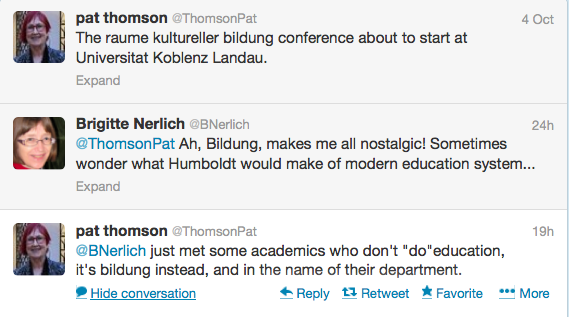
October 5, 2013, by Brigitte Nerlich
Public engagement: What to learn and not to learn from the Prussians
This blog post was inspired by three events: a talk given by Helen Pallett at the Institute for Science and Society last week; an article published in Public Understanding of Science; and a brief twitter exchange with Pat Thomson about ‘Bildung’ (ah, and the proposed closure of the Snibston Discovery Museum).
Prussian forestry
Last week Helen Pallett gave a paper that highlighted an issue relating to public engagement which is sometimes overlooked, namely its increasing institutionalisation and bureaucratisation. This trend is, however, fortunately, counterbalanced by the almost dialectical undermining of this process by those enrolled as ‘engagers’. One overarching metaphor ran through the paper, namely that of Prussian forestry, a metaphor borrowed from James C. Scott’s Seeing like a State. Scott pointed out that Early modern states’ “interest in forests was resolved through its fiscal lens into a single number: the revenue yield of the timber that might be extracted annually”, overlooking what Helen called, the “inherently messy and complex social practices” that go on in forests. Similarly to forests, the regimenting of public engagement activities may sideline, overlook or even suppress complex social practices of engagement with science going on within society.
Ecological validity
By accident, I then came across an article by Pat Gehrke entitled “Ecological validity and the study of publics: The case for organic public engagement methods”, where he argues for “a method of public engagement grounded in the criteria of ecological validity”. The advice seems to be: replace Prussian forestry with organic forestry when it comes to public engagement. He proposes an approach to public engagement that uses “organic engagement methods” which “engage publics in the places where they already exist and through those discourses and social practices by which they enact their status as publics”.
Bildung
That brings me to Bildung and Humboldt, believe it or not! A few days ago Pat went to a conference at the University of Koblenz-Landau on Räume kultureller Bildung which led to the following exchange
 Wikipedia points out that “Friedrich Wilhelm Christian Karl Ferdinand von Humboldt (22 June 1767 – 8 April 1835) was a Prussian philosopher, government functionary, diplomat, and founder of the University of Berlin, which was named after him (and his brother, naturalist Alexander von Humboldt) in 1949. He is especially remembered as a linguist who made important contributions to the philosophy of language and to the theory and practice of education. In particular, he is widely recognized as having been the architect of the Prussian education system which was used as a model for education systems in countries such as the United States and Japan.”
Wikipedia points out that “Friedrich Wilhelm Christian Karl Ferdinand von Humboldt (22 June 1767 – 8 April 1835) was a Prussian philosopher, government functionary, diplomat, and founder of the University of Berlin, which was named after him (and his brother, naturalist Alexander von Humboldt) in 1949. He is especially remembered as a linguist who made important contributions to the philosophy of language and to the theory and practice of education. In particular, he is widely recognized as having been the architect of the Prussian education system which was used as a model for education systems in countries such as the United States and Japan.”
Humboldt favoured an approach to education (and, one could say, public engagement with science and the arts), based on the ideal of Bildung (which has a long history in Germany), a word that is almost impossible to translate into English. Some translate it as ‘self-culture’ or ‘self-cultivation’, but that blends out the essentially social dimension of this concept.
Bildung can only flourish under conditions that allow citizens to immerse themselves in “a manifold of situations” (eine Mannigfaltigkeit der Situationen)”, which enable them “to enter freely into relationships of association and cooperation with one another, because, Humboldt argued, humans can realize their potential as individuals only in society.” The concept of Bildung therefore also has consequences for the concept of the state. Bildung can only emerge in a certain type of state. This means that “a government should not be evaluated solely by its legal system that granted freedom and liberty to its citizens but equally by how much and to what degree it helped assure the creation of such a manifold of situations and opportunities for the individual citizens to develop their human capacities”. This approach is, one can say, the antithesis to a Prussian forestry approach to education and engagement.
Snibston
And that, finally, brings me to the Snibston Discovery Museum in Coalville. In order to establish and maintain an ‘ecologically valid’ approach to public engagement that doesn’t fall into the trap of Prussian forestry, one should listen to what Humboldt said about the importance of being able to engage with science or art or any form of knowledge in a ‘manifold of situations’, to experience different ways of engaging and, as Helen pointed out at the end of her talk, to be open to experimentation. There needs to be diversity, variety and opportunity for people to find their own route into engagement (in places they can easily reach). (Of course, institutionalised public engagement events organised, for example, by Sciencewise will still be part of that ecology, but there should not be a monoculture, so to speak).
When our son was small, we took him to all sorts of local, regional and national science museums, from the Industrial Museum in Wollaton Park, Nottingham (which became, for a while, our home from home), to the National Space Centre in Leicester, to the Science Museum in London; but what he really loved to do was to go to Snibston. It just appealed to him for some reason much more than the big Science Museum, for example. Now Snibston is threatened with closure, which I find quite upsetting, as the museum itself was established after Snibston colliery was closed in 1983. We need regional museums like Snibston as part of a ‘manifold of situations and opportunities for the individual citizens to develop their human capacities’, to engage in Bildung rather than regimented education and engagement, be it with the sciences or with the arts.
Image: Estonian forest (Wikimedia)

[…] von Humboldt (whom I have evoked before in another blog post) would have wept, I think, if he had witnessed such developments, as he dreamed of the unity of […]
[…] model of science communication, on the importance of colour in science communication, and on public engagement and Prussian forestry. She also contributed a post to the British Science Association blog on the changing face of […]